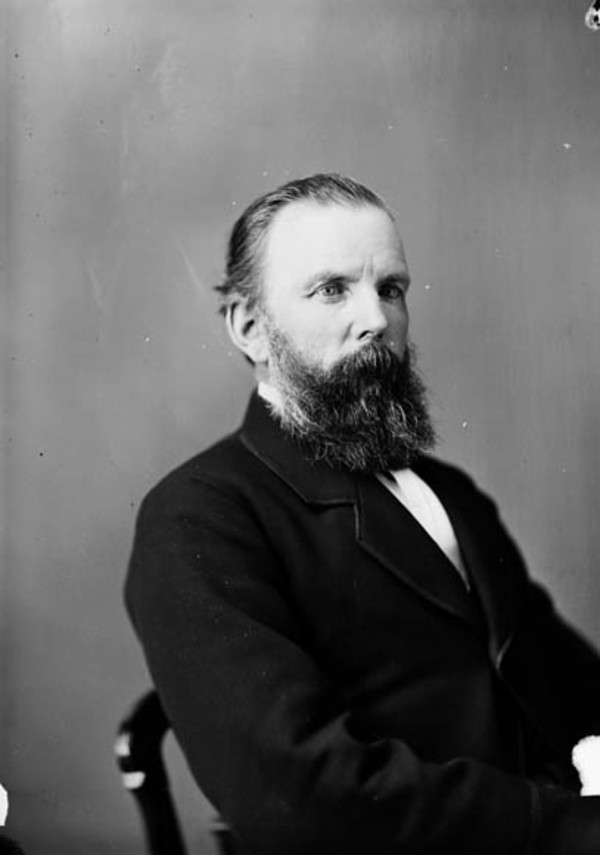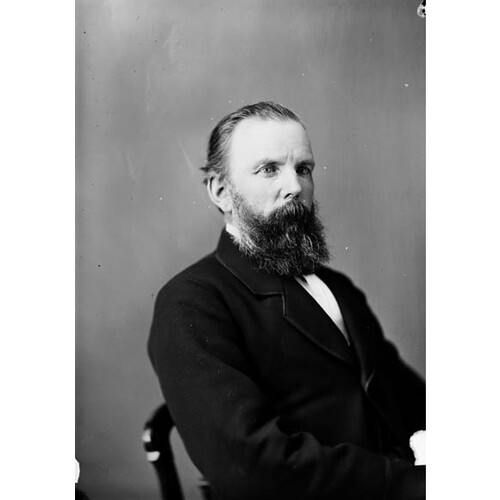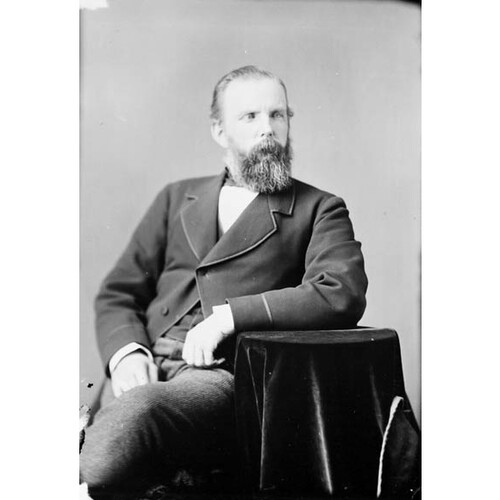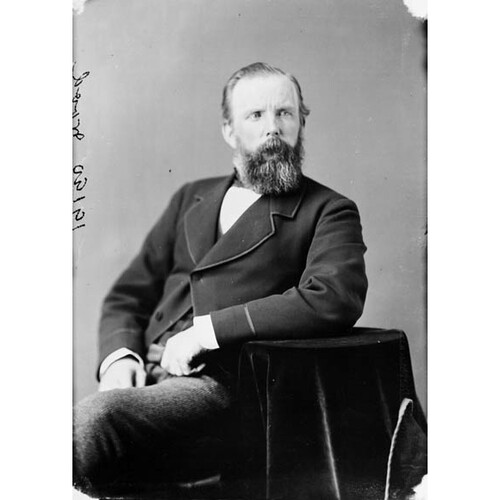As part of the funding agreement between the Dictionary of Canadian Biography and the Canadian Museum of History, we invite readers to take part in a short survey.
WOOD, ANDREW TREW, businessman and politician; b. 26 Aug. 1826 in Mount Norris, County Armagh (Northern Ireland), son of David Wood, a merchant, and Frances Bigham Trew; m. first 14 Aug. 1851 Mary Elizabeth Freeman (d. 1860), and they had two sons and a daughter; m. secondly 1863 Jane White, with whom he had three daughters; d. 21 Jan. 1903 in Hamilton, Ont.
The eldest of eight children, Andrew Trew Wood attended public school in his native village and continued his studies in Derrykeighan and Loughgilly. It is not certain when he came to Canada, but his first employment here was in James Shepard Ryan’s Toronto hardware store in 1846. Two years later Ryan assigned him to manage his Hamilton branch. Shortly thereafter, Wood left Ryan and following a succession of partnerships, all in the hardware business, he struck out on his own in April 1856. In the disturbed commercial conditions of the period, his trade was apparently so poor that in August 1857 a credit-reporting agent thought Wood was “getting into difficulty.” However, nine months later his business had so improved that he was considered “gd. for any reasonable amt.”
On 1 March 1859 Wood went into partnership with Matthew Leggat, a former bookkeeper with a rival firm. The trade of Wood and Leggat expanded and a year later Wood reported a profit of some $5,000 to $6,000. The two men found themselves in a “snug position” by late 1866, the credit agency reported, with a worth of at least $50,000 and the privilege of “get[ting] what discounts they want at Ontario Bank.” By the end of the decade, this “prud[en] oney mkg concern” was generating a revenue of $300,000 a year.
Hardware jobbing was inextricably linked to the development of the iron industry, and Wood had a material interest in various manufacturing concerns. He was a founding director of the Hamilton Tool Company in 1872, along with Leggat, Dennis Moore*, William Hendrie, and others, and held stock “to a very large amount.” His business was also closely tied to railways, with their promise of prosperity through the trade they could attract. In 1869 Wood and 16 other influential Hamiltonians had incorporated the Hamilton and Lake Erie Railway Company. Three years later he and other of its directors joined another group of local businessmen to charter the Hamilton and North Western Railway Company. From 1871 to 1875 he was a director of the Wellington, Grey and Bruce Railway Company. The general economic development of Hamilton occupied Wood’s attention as well, and he played a leading role in the organization of such important financial institutions as the Hamilton Provident and Loan Society (1871) and the Bank of Hamilton (1872).
By the early 1870s trade protection was a major concern among Hamilton’s manufacturers and wholesalers. As president of the city’s Board of Trade, Wood voted in favour of raising the tariff from 15 to 20 per cent at the 1873 meeting in Ottawa of the Dominion Board of Trade. In the federal election of January 1874, he campaigned in Hamilton as a Liberal candidate on a platform of higher tariffs and was elected along with Æmilius Irving*. One of Wood’s first acts in the House of Commons was to move for the establishment of a select committee “to consider the replies to a series of questions addressed to manufacturers of the Dominion respecting their interests.”
Although the customs policy of the Liberal government of Alexander Mackenzie* was not absolutely free trade, it was clearly influenced by free-trade theory. The tariff of 1874 was designed only to increase revenue. By 1876 financial depression coupled with the rising tide of protectionist sentiment, even within the Liberal party, put the government’s economic liberalism to its severest test. With revenues down, Mackenzie was decidedly worried by the number of government supporters from manufacturing districts who, he confided to Governor General Lord Dufferin [Blackwood], had created “a very strong party in favour of a protectionist or I might say a re-actionary policy . . . which the Government cannot wholly ignore.” Early in the 1876 session, Minister of Finance Richard John Cartwright* raised the tariff to 17 ½ per cent, a move that satisfied most Liberals but was totally unacceptable to Wood, who was pushing for 25 per cent. On 7 March Conservative leader Sir John A. Macdonald* introduced an amendment – the germ of the National Policy – that sought to appeal to the conflicting interests of manufacturers and farmers and called for a “re-adjustment of the tariff . . . to alleviate the stagnation of business.” It was defeated by a vote of 116 to 70 but had the support of Wood, Irving, Thomas Workman* of Montreal, and other Liberal opponents of the Mackenzie government’s commercial policy, who, in fact, constituted only a tiny minority within their party. However, Wood did not back the Conservatives’ protectionist position in general and he consistently voted against all subsequent amendments put forward by Macdonald. Like many manufacturers in Ontario, he feared the omnibus nature of these resolutions. Alive to his own interests and recalling the halcyon years of the Cayley-Galt tariff [see Sir Alexander Tilloch Galt*], he favoured control of the home market for manufactured products and an open market for raw materials.
The 1878 federal election saw the Conservatives swept to power on a promise of prosperity. Defeated in Hamilton, Wood concentrated his attention on his wholesale trade. At the same time, he was drawn more and more into a widening sphere of financial and industrial activity. In 1880 he joined a Toronto based syndicate headed by Sir William Pearce Howland, which was attempting to outbid its Montreal rivals for the completion of the Pacific railway. That same year he and his fellow directors in the Hamilton Tool Company, which had gone into assignment in 1880, reorganized the firm as the Hamilton Bridge and Tool Company. Wood was a founding director and a major shareholder of the Ontario Cotton Mills Company, also incorporated in 1881 (and reorganized in 1888 as the Ontario Cotton Company), and was reportedly a “large shareholder” in the Hamilton Iron Forging Company.
In 1880, following the implementation of the National Policy and while the Canadian Pacific Railway was being built westward, Wood and Leggat as special partners established a branch house in Winnipeg, under the management of Samuel F. Johnson of Seaforth, Ont. When Johnson retired in 1885, they reorganized the business by bringing in two more special partners, William Valiance, manager at the head office, and Wood’s elder son, William Augustus, who had been with the firm since 1872. His younger son, George Duncan, the branch’s accountant, was made general partner and manager. The retirement of Leggat in 1899 saw the Hamilton operations undergo similar restructuring: Valiance and his brother George, the fir-m’s cashier, and W. A. Wood joined the partnership. Under the name Wood, Valiance and Company, the firm continued to conduct a brisk retail trade and flourish as the largest wholesale hardware business in Canada, whose trade extended to Victoria. As a middleman, Wood, Valiance sustained many producers. By buying in anticipation of sales and carrying huge inventories, the firm reduced its marketing risks. Its practice was to order by the carload: 10,000 kegs of nails from the Ontario Rolling Mills Company, 200 tons of wire from the Ontario Lead and Barb Wire Company, 40 tons of twine from the Brantford Cordage Company, and 1 million bolts from the Ontario Bolt Company.
Despite the prosperity of his trade, which had made him a millionaire, Wood continued his opposition to the National Policy. He accused it of crippling the iron industry by the sheer “weight of taxation” manufacturers had to shoulder, in the form of duties on imported bar iron, coal, fire-brick, and other basic materials. In 1887 he argued for protection, by all means, but no more than what was required to enable industry “to compete with the outside producer of the same article.” Four years earlier, in fact, Macdonald’s government had begun to offer subsidies to makers of pig-iron from Canadian ore. When Hamilton passed a by-law in 1893 authorizing bonuses and a generous land grant for the establishment of an iron-smelting works and the subsequent erection of a steelworks, Wood and other leading Hamilton and Toronto businessmen seized the opportunity to incorporate the Hamilton Blast Furnace Company that year, Ontario’s first successful open-hearth iron plant. The broadening of the bounty in 1894 to include puddled-iron bars and steel billets and Ontario’s inauguration of a bounty on pig-iron produced from provincial ore further encouraged this significant new industry.
Foundation work for the plant began in November 1893 and was completed the following October. As a result of extreme depression in the iron trade during 1894 and part of 1895, there were many delays, and it was not until February 1896 that smelting operations commenced. By mid May the company had turned out nearly 10,000 tons of pig-iron, for which it found a ready market. It had intended to use ore from Hastings County, but its low grade produced a large amount of slag. Consequently, the company turned to American ore from the Lake Superior district and only began collecting federal and provincial bounties in the production year 1896. When a steel plant, spike factory, and puddling furnaces were added in 1897, the federal law was revised, thanks to Wood, to allow bounties on iron and steel produced in Canada from foreign ore.
Among local Liberals, Wood was one of the most popular politicians of his day. In 1891 he could have had the Liberal nomination, but, as he was in Great Britain en route to the east at the time of dissolution, he declined. Wood was again in Britain when nominated in 1896, but this time he accepted. He was absent during the entire campaign, and news of his victory and that of his party under Wilfrid Laurier* was cabled to him in London. With the Liberals in power, there began a general lowering of tariffs. He had advocated just such a course during the depression of the mid 1890s when protection on both sides of the border had overstimulated production. His remedy to get business back on a “healthy course” was to eliminate duties “so as to reach a revenue basis in 4 or 5 years,” a prescription that pointed back to Cartwright’s laissez-faire philosophy on trade. The lower tariffs on iron and steel products hit Wood’s firm “severely,” but he was willing to pay the price, for the new tariff structure stimulated competition between American and Canadian manufacturers and led to a more efficient Canadian industry. No doubt too the impact on Wood’s iron and steel operations was modified to some degree by federal and provincial bounties and municipal support.
During the 1897 session of parliament, Wood carried through a bill to incorporate the Nickel Steel Company of Canada. The act was applied for after the government had taken power in the Customs Act to levy export duties on nickel matte and ore. Incorporated the following year, the company was the first of three firms sponsored by Wood and other Hamilton industrialists, among them John Patterson* and John R. Moodie, that were designed to give Canada its first nickel-steel industry. The other companies, both incorporated in 1899, were the Hoepfner Refining Company and the Nickel Copper Company of Ontario. They were organized in an attempt, in which the Hamilton group was allied with Samuel J. Ritchie of Ohio, to oust the powerful American based Canadian Copper Company from its monopoly position and force it to refine its nickel and copper in Ontario. The customs law, however, was never proclaimed, despite pressure from the Hamilton group’s solicitor, John Morison Gibson*, who was also commissioner of crown lands for Ontario, and from Wood himself. The threat by Canadian Copper to shut down its operations in Copper Cliff (Sudbury) and buy its ore from New Caledonia and the fact that the Hamiltonians did not have a successful refining process were all the economic arguments Laurier needed for refusing to implement the export duty on nickel matte.
Wood and his colleagues then carried the fight to the provincial government. Through the influence of Gibson, now attorney general, they secured in April 1900 an amendment to the Mines Act which imposed a licence fee to penalize exports of nickel matte. A large delegation of mine owners and mining engineers subsequently argued that the legislation was a virtual confiscation of owners’ rights, and they urged Laurier to veto it. When Wood learned that disallowance was under consideration, he hastily wrote Laurier that such action would consign “our buildings at Hamilton with all that has been expended on them [to] the scrap heap.” The act, however, was never proclaimed by the province, and Wood’s nickel-steel interests subsequently collapsed.
Despite this set-back, Wood’s production of iron and steel was flourishing. In 1899 the Hamilton Blast Furnace Company and the Ontario Rolling Mills Company amalgamated to form the Hamilton Steel and Iron Company, with Wood as first president. This ambitious merger, which brought together the two processes of iron-smelting and steel-rolling, marked the beginning of the movement that would lead to the formation of the Steel Company of Canada in 1910.
With the approach of the 1900 election, Laurier urged Wood to seek a further term. The prime minister valued his reputation as a resourceful businessman whose forthright opinions on matters of commerce and industry were treated with respect on both sides of the commons. Laurier held him in such esteem that in 1899 he had offered him the lieutenant governorship of Ontario, to replaced the ailing Sir Oliver Mowat, but Wood declined for personal and business reasons.
At 74 years of age, Wood possessed undiminished energy. In addition to his hardware business and his interests in iron and steel, he was once more a director of the Bank of Hamilton and was president of the Hamilton Provident and Loan Society. He was also president of the Hamilton Art School and a member of the senate of the University of Toronto. Yet, despite these involvements, Wood decided to run in the election of November 1900. The national vote sustained the Laurier government, but Hamilton went solidly Conservative. In January 1901 Laurier appointed Wood to the Senate. Three months later the Ontario government named him to the board of trustees of the University of Toronto.
No less prominent in religious affairs, Wood had been a noted lay leader at Hamilton’s Park Street Baptist Church. He served as a director of the Regular Baptist Missionary Convention of Canada West and as vice-president of the Baptist Ministerial Education Society of Canada. In 1878 he sponsored a bill in parliament to incorporate the Regular Baptist Foreign Missionary Society of Ontario and Quebec. In that year he subscribed to the erection of a new church building but he would never enter it as a member. “A quiet, shy man, although capable of decided opinions,” he left his church shortly after the 1878 election, evidently as a result of an argument with another member, and joined Central Presbyterian Church. After suffering from chronic bronchitis for several years, he died in 1903 at Elmwood, his residence on James Street South, and was buried in Hamilton Cemetery.
Andrew Trew Wood’s career reflects the rising influence of modern capitalistic industry in Canada and the movement towards a national economy. Wood’s early interest in railways was directly related to his dual function, as a producer and a distributor, in providing linkages within a market that was becoming increasingly broader as the century progressed. His position as an economic integrator was of considerable importance, particularly his investments in Hamilton’s metal industries, which helped to finance long-term economic growth. Subsidization and Hamilton’s initiative in providing bonuses for an iron-smelting works were all Wood and his associates required to organize the necessary capital to erect a blast-furnace. With the addition of a steel plant, primary iron and steel making in Ontario had arrived. As a financier and industrialist, Wood was naturally drawn into politics. He was a thorough student of Canada’s trade policies and though he reputedly “possessed little oratorical ability,” according to one biographer, “in committee and in consultation with the leaders of the [Liberal] party his carefully thought out and vigorously expressed views carried weight.”
[In addition to the sources cited below, this biography is based on the Wood, Vallance and Company letter-book for 1889–98, which is in the collection of Wood-Vallance papers in the custody of Mrs David Newlands of Burlington, Ont. p.h.]
AO, RG 8, I-1-D, 1881, files 595, 607; RG 31–21, box 23.01; RG 55, partnership records, Wentworth County, declarations, box P2, nos.125, 1648–19; RG 75, O/C 28–176, O/C 33–31, O/C 33–335, O/C 35–336, O/C 37–157, O/C 42–398. Baker Library, R. G. Dun & Co. credit ledger, Canada, 25: 142, 208B, 794 (mfm. at NA). HPL, Hamilton city records, RG 1, 24 July 1893, by-law no.680; Scrapbooks, A. W. Roy: 38, 66–67. Manitoba Cooperative, Consumer and Corporate Affairs, Companies Branch (Winnipeg), Partnership declarations, no.84, 30 April 1880; no.684, 2 June 1885. NA, MG 26, G: 24546–47, 24552–56, 36381–81A, 49120–23, 55790–92; RG 2, P.C. 4232, 23 Dec. 1896; RG 30, 1533. Hamilton Spectator, 16 Oct. 1850; 2 July 1852; 10 Oct., 29 Nov. 1853; 10 April 1856; 14, 24 Jan. 1874 (evening ed.); 1, 3 Feb., 24 June 1896; 23 Jan. 1903: 10; 9 Feb. 1924: 20.
F. K. Anderson and J. B. McMillan, A history of James St. Baptist Church, 1844–1969 (Hamilton, Ont., 1969), 38–39. Can., House of Commons, Debates, 1874: 8; 1876: 131, 489–90, 684–85; 1877: 512–13; 1881: 517–18, 708; 1897: col.3661; 1902: cols.3030–34; Journals, 1878: 85; Statutes, 1878, c.35. Canada and its prov. (Shortt and Doughty), 9: 156, 201. Canada Gazette, 26 Jan. 1901: 1439. Canadian Mining Rev. (Ottawa), 20 (1901): 88–89. CPG, 1874: 271. DHB. Directory, Hamilton, 1884/85, 1896–1900. W. J. A. Donald, The Canadian iron and steel industry; a study in the economic history of a protected industry (Boston and New York, 1915). Dufferin-Carnarvon correspondence, 1874–1878, ed. C. W. de Kiewiet and F. H. Underhill (Toronto, 1955; repr. New York, 1969), 194. Genealogical and historical records of the Mills and Gage families, 1776–1926, 150 years, comp. Stanley Mills (Hamilton, 1926), 72. William Kilbourn, The elements combined: a history of the Steel Company of Canada (Toronto and Vancouver, 1960). O. W. Main, The Canadian nickel industry: a study in market control and public policy (Toronto, 1955), 53–60. Nelles, Politics of development, 92. Newspaper reference book. Ont. Gazette, 1872: 226, 573; 1880: 93, 360; 1881:113, 220. Prominent men of Canada (Adam). Standard dict. of Canadian biog. (Roberts and Tunnell), vol.2.
Cite This Article
Peter Hanlon, “WOOD, ANDREW TREW,” in Dictionary of Canadian Biography, vol. 13, University of Toronto/Université Laval, 2003–, accessed March 29, 2025, https://www.biographi.ca/en/bio/wood_andrew_trew_13E.html.
The citation above shows the format for footnotes and endnotes according to the Chicago manual of style (16th edition). Information to be used in other citation formats:
| Permalink: | https://www.biographi.ca/en/bio/wood_andrew_trew_13E.html |
| Author of Article: | Peter Hanlon |
| Title of Article: | WOOD, ANDREW TREW |
| Publication Name: | Dictionary of Canadian Biography, vol. 13 |
| Publisher: | University of Toronto/Université Laval |
| Year of revision: | 1994 |
| Access Date: | March 29, 2025 |






